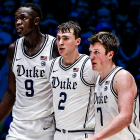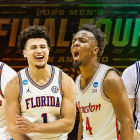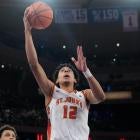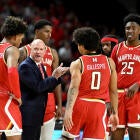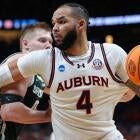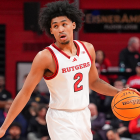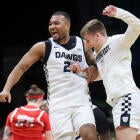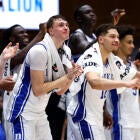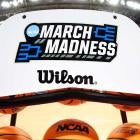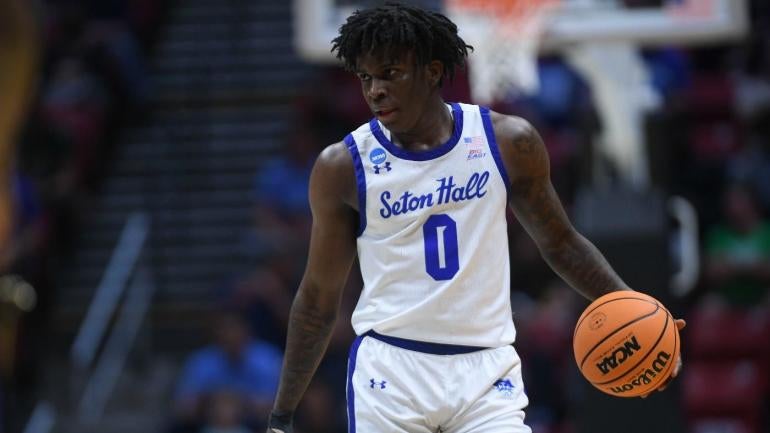
History says the Big East is pretty good at this whole transfer portal thing. The six players who were named first-team, All-Big East last season were in the transfer portal once upon a time. Tristen Newton? East Carolina transfer. Cam Spencer? Rutgers transfer. Baylor Scheierman? South Dakota State transfer. Tyler Kolek? George Mason transfer. Devin Carter? South Carolina transfer. Kadary Richmond? Syracuse transfer.
That's a good pitch in the portal moving forward. Marquette chose not to add anyone out of the portal (we'll see if that strategy was smart), but every other Big East team added numerous transfers to buff up their respective rotations. The hits (and misses) in the portal will loom large in a league that's expected to be a menace next season.
Let's dive into the realistic expectations for each of the 46 transfers set to suit up in the Big East next season.
Butler Bulldogs
Patrick McCaffery, from Iowa
Expected role: Wing rotation
McCaffery will turn 25 next March, so he's a grizzled veteran. The 6-foot-9, 210-pound forward should see minutes off the bench behind Pierre Brooks and Jahmyl Telfort. Brooks and Telfort were iron soldiers last year who never came off the floor. McCaffery is a much better depth option than Butler had in the past on the wing, so maybe Thad Matta won't have to ride Brooks and Telfort as much. McCaffery has to hold up his end of the bargain, though. He's a solid shooter who you have to respect from 3-point range and McCaffery has the size to elevate from the midrange. But, he's not much of a defender or creator. Ideally, Butler can use him as an off-the-bench, floor-spacing wing who isn't asked to do too much.
Jamie Kaiser, from Maryland
Expected role: Wing rotation
The paint was always packed with bigs at Maryland, so Kaiser basically only shot jumpers last season. Very few of 'em went in. Kaiser shot just 26% from downtown on 113 attempts. Butler is banking on a better ecosystem lending better results. Kaiser is likely fighting for minutes off the bench, but his defensive versatility and IQ give him an edge. Kaiser's defensive tape as a freshman in the Big Ten was pretty encouraging. He picked up Maryland's switch-everything defense, and he even earned some assignments on Wisconsin star AJ Storr in the Big Ten Tournament. Kaiser, a 6-foot-6, 205-pound wing, isn't just someone who could sub in for Brooks or Telfort. Playing all three of them together could give Butler's wing corps a different look with some real defensive switchability and bite.
Kolby King, from Tulane
Expected role: Potential starting guard
Tulane limited some of King's on-ball reps because of his 20% turnover rate in pick-and-roll actions. But, he clearly has juice. He's one of the shiftiest guards on this roster. King is a bit undersized (6-foot-2, 175 pounds), but he shot over 64% at the rim on a high volume. King constantly got into the paint in Tulane's five-out system and shot 37% from downtown on 95 attempts. That aggressiveness and shot-making will be relied on heavily in the half-court, but he's at his best in transition. Butler's transition offense was pretty mediocre last year, but King is a blur in the open floor.
He hasn't proven to be a trustworthy floor general yet, but his stock will soar if he can develop that part of his game. A sixth-man role could make sense, but King might just fight his way into this starting lineup for good. He'll play plenty of minutes.
Creighton Bluejays
Jamiya Neal, from Arizona State
Expected role: Starting wing
Creighton is betting on its ecosystem to get the most out of Neal. The 6-foot-6, 185-pound wing should instantly be the best perimeter defender on the team. With Ryan Kalkbrenner looming at the rim, Neal should be free to go over the top of every screen for rearview contests. Arizona State had him guard a lot of shooters last year, but Neal should get the first crack at some of the Big East's best scorers like: Kadary Richmond, Wooga Poplar, Ryan Conwell and Kam Jones.
Neal has not registered an above-average offensive rating in his first three seasons of college basketball (mostly because he's a career 27% shooter from 3-point range). But, he's an excellent transition scorer who will add a different element to Creighton's mix than jump shooters like Pop Isaacs and Steven Ashworth.
Creighton is associated with guards who can rain fire from downtown. That's not Neal's game, but this fit could end up working out well for both sides if Neal embraces a less-is-more approach with his offensive role.
Pop Isaacs, from Texas Tech
Expected role: Starting guard
Greg McDermott has a long history of maximizing his best offensive players. Isaacs should be up next to jump on Creighton's jetpack joy ride.
There are some size concerns in this Creighton backcourt. Ashworth is just 6-foot-1 and 170 pounds while Isaacs is 6-foot-2 and 180 pounds. But, the spacing should be immaculate. Ashworth's range is clear, but Isaacs is just as deadly from downtown. Isaacs' efficiency last year was down, partially due to a hip injury and some iffy shot selection. But he's fearless and hard to contain off the bounce. Isaacs shot just 43% at the rim as a freshman, but that improved slightly to 48% last year. Is another spike coming?
He has more on-ball juice than Ashworth, but both should get turns handling the point guard duties. That should ease the load on a duo that will be expected to be productive every night. Isaacs will be Creighton's best late-clock option and his pick-and-roll chemistry with Kalkbrenner should be on full display. Isaacs is a safe bet to lead this team in scoring.
DePaul Blue Demons
Jacob Meyer, from Coastal Carolina
Expected role: Starting shooting guard
Meyer is just wired to score. That will be his role for this DePaul club. The 6-foot-2, 195-pound guard shot over 40% from 3-point range last year on 102 attempts. He's a good, capable shooter, but Meyer makes his money as a slasher who can attack gaps. Meyer doesn't have insane positional size, but he's compact and strong.
Meyer is also very skilled. He struggled to finish at the rim last year, but he has a nifty floater that he can uncork with either his dominant left hand or his right hand. He's almost ambidextrous.
DePaul's backcourt additions should help Meyer shift into a score-first role without worrying too much about being a big-time creator. He's capable of making good reads, but the turnovers were frustrating. Opposing defenses started blitzing him in pick-and-rolls routinely and he didn't have much of an answer for it.
But he's shown a natural inclination to get buckets. He's one of the most natural scorers on this DePaul roster.
Isaiah Rivera, from UIC
Expected role: Starting wing
Rivera is a phenomenal shooter. He's a career 40% 3-point sniper and Rivera puts so much pressure on opposing defenses with his gravity. Rivera drained 48% of his catch-and-shoot 3-pointers last season and UIC ran him off handoffs for tough, on-the-move treys.
The 6-foot-5, fifth-year senior should be a plug-and-play starter and Chris Holtmann could use him a little similarly to what he did with Sean McNeil at Ohio State a couple years ago.
Rivera also shot 58% at the rim and started to show off a comfort getting to a one-dribble, pull-up jumper when his defender overplays the 3-pointer. He's best as a spot-up guy, but Rivera has a little game off the bounce, too. UIC didn't run him off a ton of pick-and-rolls, but he was effective in his opportunities. He could be one of DePaul's most valuable offensive players because of the space he creates for others.
David Skogman, from Davidson
Expected role: Starting big man
Skogman will give a different look to DePaul's frontcourt. The 6-foot-10, 235-pound center is a legit floor spacer. Skogman is a career 42% from beyond the arc and he shot 47% from distance last year on over four attempts per game. He should keep the paint clear for Layden Blocker to attack the rim with a vengeance. Skogman is not much of a rim protector, but he's mobile, long and active on that end. The fifth-year senior should have the inside track on a starting gig.
David Thomas, from Mercer
Expected role: Guard rotation
Holtmann is stacking talent in the backcourt and he'll let preseason workouts settle the depth chart. Thomas will certainly be in the mix for playing time after a strong freshman season at Mercer. Thomas, a 6-foot-2, 195-pound guard, is going to be a dynamic pick-and-roll scorer one day. He showed flashes last season with a two-to-one, assist-to-turnover ratio to complement his scoring binges. Thomas can kill drop coverage with his pull-up jumper and he shot over 39% from 3-point range last season. Thomas also shot 60% at the rim.
There's a lot to like about Thomas' game. He smells like a rotation guard who has the opportunity to earn a starting role.
JJ Traynor, from Louisville
Expected role: Wing rotation
Traynor is an off-ball wing who will bring some much-needed size to DePaul's roster. He's a legit, 6-foot-8 and Traynor could earn a spot in the starting lineup if he commits to being an asset defensively and one of the best rebounders on the team. He's certainly more of a play-finisher who can stretch the floor a little bit, but it's not a big-time strength. It's unlikely that DePaul would give Traynor a bunch of on-ball reps or use him as a mismatch-hunting offensive weapon, but he can be a useful part of this rotation with his defensive versatility, athleticism and bite on the glass.
Troy D'Amico, from Southern Illinois
Expected role: Wing rotation, potential starter
D'Amico projects to be a low-usage, high-impact wing for DePaul who makes 3s, knows his role and will show up on the defensive end. D'Amico shot over 36% on his catch-and-shoot 3-pointers last season, and he can also curl around screens and get to the cup. He's most comfortable operating out on the perimeter as a spot-up threat, but D'Amico is a willing passer who will find open cutters. He's not an elite athlete, but his endurance was on display last year. He rarely came off the floor last year and played all 40 minutes in three games.
NJ Benson, from Missouri State
Expected role: Frontcourt rotation
Rebounding is a real question for this DePaul group, but Benson could solve a lot of those problems. The 6-foot-8, 225-pound forward was one of the top rebounders in the Missouri Valley last season and his impact on Missouri State was clear. Missouri State had a +5.5 net rating with Benson on the floor and it sunk to -5.4 when he sat. That's nearly an 11-point swing. Missouri State's rim defense was much worse without Benson on the floor. Benson is pretty clearly the best shot-blocker on this roster. DePaul could experiment with Benson at the 4 and Skogman at the 5 to get some size out there in some matchups. Skogman and Benson both doubled the post often last year, so DePaul could utilize that gameplan against some of the better Big East centers.
Skogman's ability to stretch the floor helps cover up Benson's weaknesses as a shooter. Benson does basically all the dirty work in the paint. I think he finds a way to make a real impact on this group because his strengths are different than the rest of the roster.
Conor Enright, from Drake
Expected role: Backcourt rotation
Oh, would you look at that? DePaul landed another guard who can shoot. Sensing a theme? Enright shot over 43% on 90 catch-and-shoot 3-pointers last year. He's a deadeye when he can get his feet set. He also was one of Drake's better point-of-attack defenders.
But he might be closer to an undersized off-guard. That's a tougher archetype to make work in the Big East. Drake limited his pick-and-roll usage last year, and he still turned it over on over 26% of his 50 possessions in ball screens.
If Enright could stick in Drake's rotation, he should be able to find a role for this new-look DePaul club with his defense and shooting. But he's not a true point guard (yet).
Layden Blocker, from Arkansas
Expected role: Starting point guard
DePaul has added so much shooting on the perimeter, but it needs someone to break down the defense and get into the paint.
Insert Blocker. The Arkansas transfer is the most natural point guard on this roster and he punctured opposing defenses at will last season. He should lead this team in free throw attempts while offering nasty perimeter defense. The former prized recruit has a runway to a major role at DePaul and the roster construction is set up to best maximize his skills and keep the paint clear for his drives.
This could end up being an absolute gem for DePaul.
Expected role: Wing rotation, potential starter
It's wait-and-see mode for Gunn. He might have a higher ceiling than some of the other wings on this roster, but he's vastly unproven. The 6-foot-6, 200-pound wing couldn't carve out a significant role for an Indiana team that was desperate for shooters. When he did get run, he scored 17 points on 15 shots against Nebraska in a Big Ten Tournament blowout loss. He drained three 3-pointers in a blowout loss to Purdue in early February. Gunn had no fear of firing from well beyond the NBA range and he has faith in his pull-up jumper. But, he just hasn't played a lot over the past two seasons. He'll be in the mix for minutes and a potential starting spot if things click.
Georgetown Hoyas
Malik Mack, from Harvard
Expected role: Starting guard
Mack, a 6-foot-1, 170-pound point guard, will be thrown into the fire right away. Mack is a plug-and-play starter who will be the main initiator for this Georgetown offense. That should shift junior combo guard Jayden Epps into his natural, score-first role.
The Epps-Mack duo has lots of questions defensively, but it has a chance to be a tough cover offensively.
Mack is just so shifty and a capable three-level scorer. He had to be the engine of Harvard's club as a freshman, so his efficiency dipped in some spots. He was just 51% at the rim and 36% on his midrange jumpers. But the jumper is translatable and pure. He shot 34% from 3-point range on high volume and 81% from the charity stripe.
Mack has all the tools to be one of the better point guards in the Big East, especially because of his playmaking. Mack showcased the smarts to take the easy openings, but his film is littered with some two-hand, frozen ropes or one-handed, live-dribble whips to shooters.
Mack is the jewel of Georgetown's transfer haul for a reason.
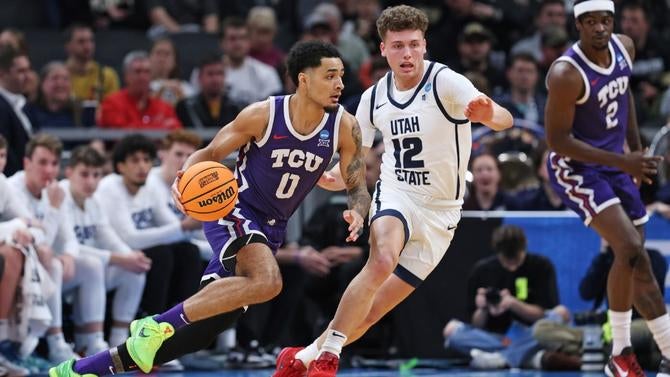
Micah Peavy, from TCU
Expected role: Starting wing
Georgetown had one of the worst transition offenses in the country last year — partially because it was constantly taking the ball out of the net after giving up yet another bucket. Peavy is expected to solve this problem.
The 6-foot-8, 215-pound wing is a phenomenal defender who can legitimately hang with all five positions and he was one of the better transition scorers last year for a TCU team that wanted to run like crazy.
Peavy will not be Georgetown's best player, but he's going to be a rotation lynchpin who can provide that rangy defensive wing next to Mack and Epps. Peavy should be the guy Ed Cooley relies upon to guard the top perimeter studs in the Big East.
He's worked hard to become more and more of an asset offensively. He can pass it. He can handle it. He rebounds. He made more 3-pointers last year (27) than the previous three years combined (21). Peavy won't ever be a high-volume shooter, but you can't ignore him anymore. If he cuts hard, Mack will find him, too.
It's hard to envision Georgetown trotting out many net-positive lineups that don't include Peavy.
Jordan Burks, from Kentucky
Expected role: Wing rotation, potential starter
It's hard to take anything away from Burks' freshman year at Kentucky. He played so little for a team that was loaded with guards. Like Kentucky, Georgetown will hum through its guards. But, Burks has a shot to be the starting 4-man who provides oomph on the glass and a play-finisher in both the half-court and transition. Burks needs to expand the skill aspects of his game, but he played with a great motor off the bench. A revved engine will keep him on the floor for this club.
Curtis Williams, from Louisville
Expected role: Guard rotation
Georgetown has very little guard depth, so Williams could have the inside spot to be the fourth guard in the rotation behind Mack, Epps and Peavy. There's a real role to earn, here. Williams has a sturdy, 6-foot-5, 205-pound frame to pair with a jumper that is far from broken. Williams' form his pretty clean. He only shot 28% from downtown last year, but that number should go up. Can he become a serviceable 3-and-D guard?
Providence Friars
Bensley Joseph, from Miami
Expected role: Guard rotation, potential starter
Joseph might start. He might come off the bench. It doesn't really matter. The veteran guard knows his role. Joseph has been a good shooter throughout his career, and he'll make shots for Providence next year. He shot 36% from downtown on catch-and-shoot 3s and off the bounce this past season. Joseph can also handle some of the ballhandling role, but he had a high 27% turnover rate in ball screens last season. He's a bit of a high-risk, high-reward playmaker. He's certainly one of Providence's best four guards who will play starter-caliber minutes.
Wesley Cardet, from Chicago State
Expected role: Starting wing
Cardet is going to be a big part of the Devin Carter Replacement Plan. The 6-foot-6 wing just wants to get to the rack. Over 50% of his shots last year came at the rim and he had a sky-high free throw rate. Playing off two feet will be essential to finish off his drives a bit better. Cardet is capable of getting going from all three levels, but simplifying his game will be key to finding success in a Big East that is so well-scouted
If healthy, Bryce Hopkins is Providence's alpha, but Cardet is another capable double-digit scorer who can be the engine of the offense. He's a better shooter than the numbers suggest. He shot over 35% on his catch-and-shoot 3-pointers last year, but he rarely played off the ball at Chicago State. Getting freed up for more spot-up opportunities should help Cardet's efficiency rise.
Less on-ball responsibilities should help Cardet have more energy to expend on the defensive end. Coach Kim English will need him to be a nasty perimeter defender from the jump.
Jabri Abdur-Rahim, from Georgia
Expected role: Starting wing
Abdur-Rahim is a big shooter who should keep the floor spaced for Hopkins' booty-ball and Cardet's drives. Abdur-Rahim shot 35% on 174 attempts from 3-point range last year and he'll likely be Providence's best 3-point shooter next season. The 6-foot-8, 215-pound forward also sneakily gets to the line a lot. A lot of that comes in transition, but Abdur-Rahim smartly uses head fakes to draw a bunch of contact in the paint. He also got fouled on numerous 3-pointers last year.
We'll see if that translates. On one hand, Providence had the highest free throw rate in the Big East last year. On the other, SEC games routinely turned into a foul fest. The SEC had the seventh-highest free throw rate among the 32 conferences last year and it was No. 1 among the high-major leagues. The Big East? It had the lowest free throw rate in the country. The league is filled with teams who try so hard to defend without fouling.
Christ Essandoko, from St. Joseph's
Expected role: Starting big man
Essandoko is oozing potential. He's all of 7-feet tall and he checks in at 285 pounds. With Josh Oduro out of eligibility, the table is set for Essandoko to be Providence's go-to center. He has the tools to be a stud down the road, but he can help the Friars out a ton right away. Essandoko is mostly a drop-coverage big man, but his much-improved mobility is so obvious.
Essandoko has the makings of a legitimate two-way monster. He's not a great post-up scorer yet, but he can give teams so much trouble with his fluidity in pick-and-rolls.
His hands are solid but could be better. His jumper is real and could be better. His decision-making is OK but could be better. Providence could have a highly impactful big man on its hands here if the player-development program flexes its muscles.
The finish was not there, but a 7-foot, 285-pound big man moving like this?
— Isaac Trotter (@Isaac__Trotter) July 17, 2024
New Providence center Christ Essandoko is going to be a super interesting player to monitor. Big offseason for him. Don’t think he’s far away from being a really impactful player for the Friars. pic.twitter.com/bsprv2ZaUY
Seton Hall Pirates
Chaunce Jenkins, from Old Dominion
Expected role: Starting guard
Jenkins is an interesting player. The 6-foot-4, 173-pound guard has an absurd wingspan which shows up on the defensive end. He had a 3.5% block rate which is an incredible number for a guard. Only five college players 6-foot-4 and under had a block rate over 3.5%, per Bart Torvik. Jenkins was one of the five and that length shows up on tape. Synergy credits Jenkins with blocking five 3-pointers.
That's not everything. Old Dominion had a terrible defense overall, but it's not nothing either, especially when Shaheen Holloway is one of the top defensive coaches in the country.
Jenkins looks like a no-doubt starter thanks to his bucket-getting abilities at all three levels and some of the defensive traits he possesses. He's more of a scorer than a play-creator, but that's what Seton Hall needs.
Garwey Dual, from Providence
Expected role: Backcourt rotation, potential starter
Dual reiterated to CBS Sports at the NBA Draft Combine that he wants to play point guard. He should get that opportunity for on-ball reps at Seton Hall. The 6-foot-5 guard has to show some signs of growth as a shooter to reach his full potential, but he can be a helpful Big East player right away because of his defense. Dual is enormous and has a massive wingspan that was measured close to 7 feet. He can guard anybody and everybody. At minimum, Dual should embrace being hellacious defensively and a jumbo creator for Seton Hall. If the jumper ever comes around, watch out.
Scotty Middleton, from Ohio State
Expected role: Starting wing
You don't want to fall in love with small sample sizes, but Middleton's flashes at Ohio State are hard to ignore. Everything looks better when you shoot 46% from 3-point range on just 62 attempts, but he should head into his sophomore season at Seton Hall with plenty of confidence. the former prized recruit was utilized as an off-ball wing at Ohio State who only had a 15% usage rate. Seton Hall can bump that up a bit, but we'll see just how ready Middleton is to be one of the top guys on the scouting report. If the 3-point stroke is real, Middleton will be a massive piece of this club. Holloway needs him to stretch the floor, attack long closeouts and be a nasty wing defender.
He left Ohio State looking for more. Seton Hall gives him the chance at a huge role. What's Middleton going to do with it?
Zion Harmon, from Bethune-Cookman
Expected role: Backcourt rotation
The 6-foot, 165-pound guard is a career 88% free throw shooter, so the signs are there that he can shoot it. He just hasn't done it yet at a high level. Harmon is a career 28% from beyond the arc. Seton Hall needs a big jump in that department for this to work. Harmon is likely a depth piece because of his obvious defensive issues, but he does pressure the basketball at a high level and he can get wherever he wants on the floor and set the table. His playmaking and on-ball juice is something that Seton Hall needs. His 22% turnover rate in pick-and-rolls is a scary thought in the Big East.
Prince Aligbe, from Boston College
Expected role: Starting forward
Aligbe has legitimate, high-major experience which gives him a leg up in this Seton Hall frontcourt. The 6-foot-7, 225-pound forward is a good athlete who plays hard. He is active on the glass and can push it in transition. So far, Aligbe's jumper just has not become an asset. He's just 18-for-82 (22%) from 3-point range throughout his career. Improving his touch around the rim and from downtown would be a huge development. But, he's a rangy athlete who can guard multiple positions. That's what Seton Hall's defense needs. He'll play early and often, but Aligbe won't be asked to be an alpha scorer.
Gus Yalden, from Wisconsin
Expected role: Frontcourt rotation, potential starter
Yalden is a former four-star prospect who had some off-court snafus at Wisconsin that kept him off the floor. But the talent is still there, and Seton Hall has a wide-open frontcourt. Yalden has reshaped his body to get ready for the opportunity. He projects as a silky-smooth, post-up weapon who has plenty of skill. His next college game will be his first. But it's a good talent bet for a frontcourt that has no proven commodities.
Yacine Toumi, from Evansville
Expected role: Frontcourt rotation
Toumi is rail thin, but the 6-foot-10, 200-pound big man has some skill. He hasn't become a 3-point threat yet, but Toumi loves to face up and get to a 17-foot jumper in the middle of the floor. The veteran makes enough of them to earn the respect of the defense, and then he can drive it a little bit. The length shows up on the glass, but Toumi has a hard time defending without fouling. He's not strong enough to hang with Big East 5s, so he's probably better suited hanging with 4s.
Emmanuel Okorafor, from Louisville
Expected role: Frontcourt rotation
Okorafor is still so raw and hasn't played much over the last two years, but he's immediately one of the better athletes in this frontcourt. Holloway will keep it simple for him in the early-going, but the 6-foot-9, 220-pound forward will play if he embraces his role as a rim protector, rebounder and lob threat.
UConn Huskies
Tarris Reed Jr., from Michigan
Expected role: Frontcourt rotation
UConn has made a big man platoon a huge part of their roster-construction gameplans, and it's not going anywhere in 2024-25. Samson Johnson and Reed will form a two-headed monster. Johnson is bouncy, athletic and extremely fast. Reed will bring more power. The 6-foot-10, 265-pound big man has been watching plenty of Adama Sanogo tape. That type of physical, low-post monster is such a different archetype compared to Johnson.
Reed is an elite rebounder, and he's going to draw fouls because of his activity and pure, raw power. But, he still has so much room to grow, and UConn's proven player-development group will be huge for him. Reed is a career 51% free throw shooter. He's still tweaking his back-to-the-basket game. UConn demands its big men to be willing playmakers, and that's an area of Reed's game that has to grow significantly.
But, all the potential is there for Reed to follow in that Sanogo-like path. It's hard not to be bullish on Reed's fit with UConn after what Dan Hurley has done with some of these big men lately. Plus, the intel of Reed as a person is just off the charts. He will rapidly get better.
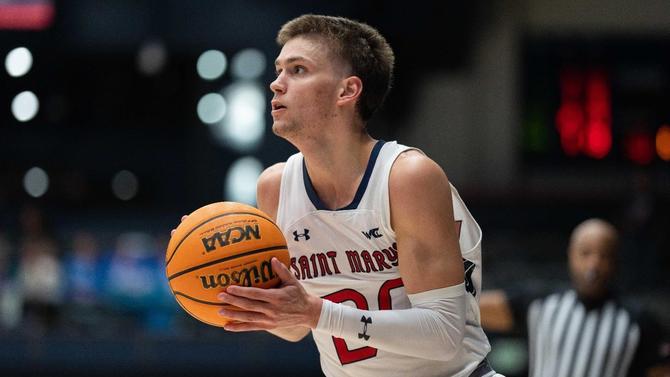
Aidan Mahaney, from Saint Mary's
Expected role: Starting guard
Mahaney is the only player on this UConn roster who has been the No. 1 option on the scouting report in college. That'll be invaluable.
The 6-foot-3 junior guard has all the qualities that Hurley wants. He's tough. He's a winner. He's reliable. He's smart. Oh, and he can shoot it. Mahaney shot 38% on his catch-and-shoot 3-pointers as a sophomore and 46% as a freshman. Per Synergy, no high-major team generated a higher percentage of open catch-and-shoot 3-pointers last season than … UConn. Conveniently, the Huskies were just barely ahead of Saint Mary's.
So yeah, this is probably going to work out really, really well for both sides.
Mahaney should fit like a glove in this UConn backcourt as a scorer who can handle it and create. He's unselfish and makes good decisions. Mahaney's lack of tip-top athleticism shows up on his shot chart. He doesn't have a high free throw rate. He doesn't get to the rim a lot and he's shot under 50% at the rim in each of the past two seasons. But, UConn's sets-oriented schemes should help cover up some of those small warts in his game and Mahaney will get better at 'em as he gets stronger.
Mahaney also has numerous examples of late-clock brilliance. When the shot clock is dwindling, he'll be comfortable with the ball in his hands. There's All-Big East potential here.
St. John's Red Storm
Kadary Richmond, from Seton Hall
Expected role: Starting guard
Richmond was one of the best two-way players in the country last year, and Rick Pitino will demand him to ramp his game up to a new level. Richmond is a 6-foot-6 guard who mostly fits in the scorer/creator bucket. He stuffs the stat sheet and will be a triple-double threat in every game. Richmond is constantly creating advantages. He blends acceleration and deceleration really well, and St. John's should be able to use him as a post-up weapon who can find an open man if a second defender comes.
Richmond's 3-point numbers won't jump off the page, but he's improved as a shooter, especially in the middle of the paint. He's also worked to become an 80% free throw shooter which is a huge development because he'll get to the line a ton.
A jumbo creator who is a certified alpha is a cheat code, but Richmond can make a run at Big East Player of the Year with his defense. Pitino wants to build a turnover-forcing, heavy-pressure defense, and Richmond can do all of it. Seton Hall played slow the last few years. St. John's wants to play fast. That's an adjustment but it could be a good thing for Richmond.
Deivon Smith, from Utah
Expected role: Starting guard
A second Mr. Triple Double is heading to St. John's. Smith's speed, competitiveness, defense and court vision should be everything Pitino craves from his point guards.
But the fit between Richmond and Smith has been questioned from the start. Both high-usage guards aren't high-volume, 3-point shooters. But Richmond is more of a halfcourt hub and Smith is awesome in transition. That push-pull should add some diversity to St. John's profile.
Smith was also a very solid, set shooter last year. He drilled 41% of his 46 catch-and-shoot 3-pointers. When teams tried to help off him to double-team Utah star Branden Carlson, Smith made 'em pay. St. John's could tempt opposing defenses into doing the same with Smith feeding Richmond a post-up on the same side of the floor. If the double comes, Smith could be in position for more open 3s with his feet set.
But the drives might be more important than the shooting. Smith is a phenomenal driver. He shot over 61% at the rim last year on a ton of volume, and he can create so many long closeouts with his creative dishes. Richmond is a handful against set defenses, but against a scrambling one? Game over.
Those drives will be St. John's path to efficient offense despite having two iffy shooters who want to have the ball in their hands so much.
Aaron Scott, from North Texas
Expected role: Starting forward
Richmond and Smith are the big-name gets, but Scott is such a stud. There was a real dearth of stretch 4s in the portal, but St. John's landed one of the best out there. Scott shot over 37% on 115 catch-and-shoot 3-pointers last season, and he is very comfortable getting into his post-ups from the slot. Plus, Scott projects to be an outstanding multi-positional defender. His floor spacing will be invaluable for St. John's. He might never sit.
Vince Iwuchukwu, from USC
Expected role: Frontcourt rotation
Iwuchukwu is a former top-30 prospect who is still figuring things out after a remarkable comeback from cardiac arrest. He'll likely team up with Zuby Ejiofor (and maybe Khaman Maker) to form a center platoon. Iwuchukwu is enormous, checking in at 7-foot-1 and 240 pounds. His path to minutes will be on the defensive end as a rim protector and a lob threat for Smith and Richmond. If he runs the floor hard, he will get fed by Smith who is always looking to make the look-ahead dime in transition. St. John's has the depth and the guard talent to not have to ask too much of Iwuchukwu yet.
Xavier Musketeers
Ryan Conwell, from Indiana State
Expected role: Starting guard
Xavier scored the fifth-most points off handoffs last year, per Synergy. It added one of the best shooters in the portal who excelled on … handoffs. Only 15 players in the country made more 3-pointers off handoffs than Conwell last season.
Conwell-to-Xavier is one of the best pure fits in the transfer portal. Conwell's shot profile is all 3-pointers or stuff at the rim. Conwell splashed over 42% of his catch-and-shoot triples and also shot over 62% at the rim. He was one of the best shooting guards in the country last year, and he's going to a scheme that excels at letting snipers cook. Conwell only has one season under his belt where he was a plus-shooter, but if that sticks (as expected), he can be one of the best players in the Big East.
Dante Maddox Jr., from Toledo
Expected role: Guard rotation, likely starter
Maddox has shot over 40% from 3-point range in three of his four seasons at the college ranks. The 6-foot-2, 195-pound guard is just a flamethrower.
But he's not just a shooter. Maddox showcased some real on-ball juice, and his playmaking out of pick-and-rolls has become an asset. Maddox won't be asked to be Xavier's primary on-ball creator (that's Dayvion McKnight's job), but he can certainly handle the load. He can also smartly attack long closeouts and get to the free throw line.
Maddox is just so solid. Xavier's floor spacing should be immaculate with Maddox and Conwell on the floor next to sharpshooting big man Zach Freemantle.
Lassina Traore, from Long Beach State
Expected role: Frontcourt rotation
Xavier's frontcourt depth was a dire problem last year. It won't be this year. If Freemantle and Jerome Hunter are healthy, Traore is probably the fourth big man in the pecking order. The 6-foot-10, 230-pound center play with a great motor on the glass. He's not much of a rim protector, but he can play multiple different coverages defensively against ball screens. Traore is a solid free throw shooter (69%) who will be a junkyard dawg. Xavier doesn't need him to be a star.
John Hugley IV, from Oklahoma
Expected role: Frontcourt rotation
Hugley's talent is unquestionable, but he has not been very durable. He's missed large chunks of three of the past four seasons. But when he's on the floor, he can be very effective offensively. While he's not a rim protector, he is a thumper defensively which you need in a physical league like the Big East.
Hugley is a fantastic play-finishing big man who shot over 70% at the rim last year. He's also started to develop a jumper that stretches out to the 3-point stripe. But his mobility and conditioning have been real questions.
If he can stay on the straight and narrow, the 6-foot-10, 275-pound center can be a huge piece of this team. That high-low game with Freemantle and Hugley could be a staple of this Xavier offense, and Sean Miller will have so much shooting on the floor. Can Hugley take advantage of what the defense gives him? Oklahoma helped him unlock some extra playmaking, using Hugley as a hub at the top of the key to whip backdoor passes or find shooters in 4-on-3, scramble drills. But when he tries to do too much, turnovers pop up routinely.
Hugley is one of the biggest X-Factors for this club.
Marcus Foster, from Furman
Expected role: Guard rotation
Foster is a little bit different than Xavier's other guards. That's a good thing. The 6-foot-4, 200-pound guard can really get downhill. Nearly 40% of his shots last year came at the rim, and Foster was one of the better transition scorers in the country last year.
Foster is a really smart player. Xavier should be able to use him in post ups, and while he didn't shoot it great last year, he did splash over 37% of his catch-and-shoot 3-pointers in 2022-23. He's also an awesome rebounder.
Foster gives this Xavier perimeter more size and some insurance in case some of the young guards aren't ready to go.
EDITOR'S NOTE: Xavier also added Florida State transfer Cam'Ron Fletcher and Boise State transfer Roddie Anderson III to this class. However, both are redshirting in 2024-25 and are not included in this exercise.
Villanova Wildcats
Enoch Boakye, from Fresno State
Expected role: Frontcourt rotation, potential starter
Villanova's roster construction seems destined to allow Eric Dixon to get more run at the 4 which opens the door for Boakye to play real minutes next to Nova's shotmaking lefty. Boakye was a prized recruit who did very little at Arizona State for two years before an OK year at Fresno State. He'll give this Villanova frontcourt some physicality on the glass and some added rim protection. But the 6-foot-11, 250-pound center struggled to make decisions out of post-ups and is not a good free throw shooter. That could keep him on the bench during closing time.
Jhamir Brickus, from La Salle
Expected role: Starting point guard
Brickus is the closest thing to an initiator point guard on this Villanova roster, but he's a scorer at heart. The fifth-year senior is a career 37% 3-point assassin, and he can make some tough shots from all over the floor. As expected, the 5-foot-11 guard had a low rim rate and shot just 47% at the rim in halfcourt situations.
That means for Brickus to be a good, high-major guard, the jumper has to go in. A lot.
He's certainly capable of it. He drilled 38% of his catch-and-shoot 3-pointers and 41% of his off-the-dribble 3-pointers last season. Brickus has real shake off the bounce.
The fear is that the turnover issues will pop back up. Brickus had a sky-high turnover rate in his first three seasons of college basketball. His decision-making improved a lot as a senior, but he still turned it over on nearly a fourth of his pick-and-roll possessions. Some Big East defenses like Marquette, Providence, St. John's and UConn will smell blood in the water with that.
Wooga Poplar, from Miami
Expected role: Starting guard
Poplar is really good at what he does. The 6-foot-5 guard is a proven, high-level shooter who splashed over 37% of his treys in each of the past two seasons. He's also capable of attacking the rack with a vengeance for some monster posters, and Poplar will stick his face in the fan on the glass. He's been a productive role player.
But Poplar transferred to Villanova to show he can be more than just a spot-up guard. Poplar wants the ball in his hands as a primary initiator, and Villanova's backcourt needs a star. Poplar believes it's his turn to prove that he can be that alpha once and for all.
Tyler Perkins, from Penn
Expected role: Backcourt rotation
Perkins is likely to be the first guard off the bench for Kyle Neptune. The 6-foot-4, 205-pound guard put up some impressive showings as a freshman for an undermanned Penn squad. He shot 35% from 3-point range overall, but Perkins was a way better shooter off the bounce (46%) than on his catch-and-shoots (28%). We'll see if that means anything or if it was just random. It's unlikely he'll have the ball in his hands a ton with Poplar and Brickus in the fold, so being a knockdown, spot-up weapon will be necessary to get on the floor.
Villanova loves to let its guards post up and go to work. That might be a sneaky-big part of Perkins' game next year. He didn't do it a ton at Penn, but the lefty is pretty comfortable operating down there, staying under control, playing off two feet and getting back to his left hand for finishes in traffic.
Defensively, Perkins has a lot of work to do. Penn was one of the worst defensive teams in the country last year. But he was a freshman and he has good positional size, so there's a bit of upside on that end.
![[object Object] Logo](https://sportshub.cbsistatic.com/i/2020/04/22/e9ceb731-8b3f-4c60-98fe-090ab66a2997/screen-shot-2020-04-22-at-11-04-56-am.png)



















